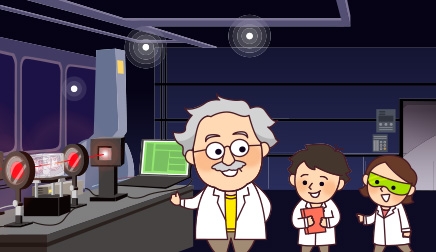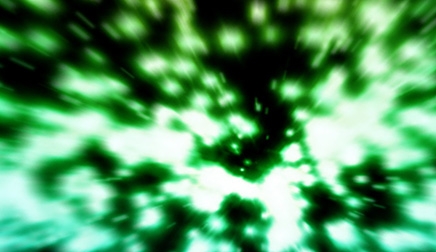 Home > Professor lights > Vol.02 Takahiro ANDO
Home > Professor lights > Vol.02 Takahiro ANDO
Vol.02 Takahiro ANDO
Transforming
photons and time into art

Takahiro Ando
Artist & Creator
http://www.andou.info/
Profile Born in Tokyo in 1965. Graduated from the Tokyo University of the Arts, Oil Painting in 1991. After serving as education & research assistant at the Tokyo University of Arts, worked as a lecturer (non-full-time) at the same university until 2012. Recent exhibition works include “Mission [SPACE×ART] – beyond Cosmologies (Tokyo)”, “Kawagoe Light, Sound, and Culture Festival (Saitama)”, “Roppongi Art Night 2013 (Tokyo)”, and “Biophotons (Korea).”
Takahiro Ando succeeded in expressing as art, the mysterious feelings found though experiencing individual particles of light as physical sensations. The key to making this work a reality is the photomultiplier tube*1. His next work created a fantastic world where photons (particles of light) glitter and twinkle, by capturing the very low light emitted from plants when they sprout. Let’s take a closer look at the expressive techniques of this artist who is opening up new frontiers in light and art.
Listening to the sound of individual photons
Challenging the biophotons beyond the “awe-inspiring” feeling
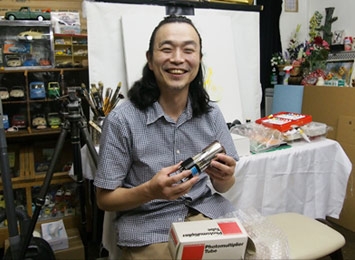
Listening to the sound of individual photons
A “photomultiplier tube” converts light signals into electronic signals and exponentially multiplies and outputs these electronic signals. As both an artist & creator, Takahiro Ando was fascinated by the possibilities offered by the photomultiplier tube. He utilized the photomultiplier to produce a unique device that detects very weak light leaking into a completely dark room and converts those individual particles of light into a sound that we can hear as a high-pitched chirping sound noise to our ears.
Ando says: “I have been fascinated by light since I first started studying drawing before entering the university.” When Ando painted pictures, he depicted light with monotone colors of white, black, and gray rather than using the conventional technique of painting that faithfully and accurately reproduces the details. He mentions what impressed him about this technique was that “When I see a picture close up, it only looks half painted, but when I see the same picture from some distance away it looks amazing.”
This attractive style of painting caused him to become totally absorbed in the concept of using light to express art.
“One day while reading a book by Feynman*2, I found an illustration showing a photomultiplier tube that was connected to an amplifier and speaker. It occurred to me that this was a way to allow us to listen to the sounds of light by converting light into sound. Converting light into sound didn’t seem like a difficult task.” Yet at that time, Ando did not know anything about technology and science. However, he really wanted to start this fascinating work as soon as possible, so he checked every company manufacturing photomultiplier tubes and sent a letter asking for technical hints.
Ando says: “Hamamatsu Photonics immediately gave me a reply. In a kind of reverse process, they got interested in what I wanted to do with photomultiplier tubes in the world of art and so invited me to come to Hamamatsu.”
Ando’s wish soon came true. When he visited Hamamatsu Photonics, they affirmed and recognized his concept. Ando brought blueprints back with him and then fabricated an experimental device by himself. Using that device assembled with a compact photomultiplier tube, Ando attempted to convert light into sound. His device converted light particles at minimal levels into subtle sounds that could be heard. That was the moment when he succeeded in creating a work merging the visual and auditory senses with each other. This work was later packaged into a CD.
Challenging the biophotons beyond the “awe-inspiring” feeling
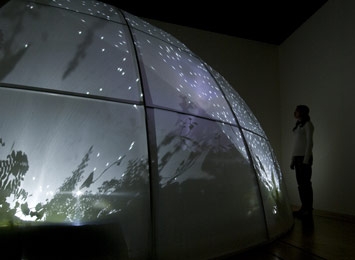
(NTT ICC, Tokyo)
Ando’s interest in light was still far from over. He says: “I kept coming up with various ideas. What I decided to try next was “art” using biophotons which are very faint light emitted from seeds of plants when they sprout.” However, to make that idea a reality there was one slight hurdle he had to overcome. He had the constant feeling that “Handling living organisms is awesome.” Ando comments “For example, if a work created while detecting ordinary light with a mechanical device is home cooking, then handling biophotons is luxury food cuisine. So I really hesitated about whether I should go on to tackle that work without a lot of careful thought.”
“During that period while hesitating about what to do, I took a walk along the river near my house and while viewing some beautiful cherry blossoms, a bug flew into my eye which really hurt! That incident helped me overcome my doubts and decided to go ahead and try it.” He said with a laugh.
At the same timing, I received a “How about creating a new work?” query from a curator of a museum displaying media-based art, who had been interested in my work after listening to the CD of light sounds I had made. So I impulsively replied “Yes, I want to create a new mode of art by using biophotons” and we quickly agreed to cooperate on this idea.
What I completed was “art” that captured and amplified biophotons with a photomultiplier tube and projected them onto a dome-shaped monitor from inside it. On this monitor, dots of light glowed as if tiny forms of life, barely breathing yet trying to insist they were most certainly alive.
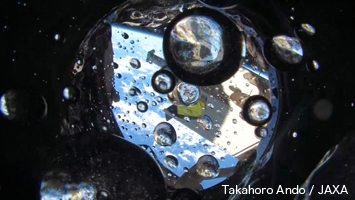
(Takahiro Ando / JAXA, 2013)
Ando has also made a creative masterpiece on the theme of ”Blue Earth Gazing” which is the Earth as viewed from space. This “Blue Earth Gazing” was achieved by spraying a water mist onto the window port of the space station and viewing the Earth through the watery surface. The theme “Blue Earth Gazing” concept arose from a traditional Japanese custom called “Otsukimi (Moon Gazing)” that started in the Manyo era (7th to 8th century in Japan). During “Otsukimi” people sit and view the beauty of the full moon while drinking from sake cups whose rice wine reflects the light of the moon. By creating this unique blend of Japanese culture, space and art, “Blue Earth Gazing” expresses the joy of viewing scenery as art that can only be appreciated for a special moment.
This “Blue Earth Gazing” was performed by astronaut Chris Hadfield on the Japanese Experiment Module ”Kibo (Hope)” in the International Space Station. It was part of pilot missions “Education Payload Observation” (experiments aiming at discovering the wonders and impressions revealed by the Earth and Universe through artistic expression, etc.).
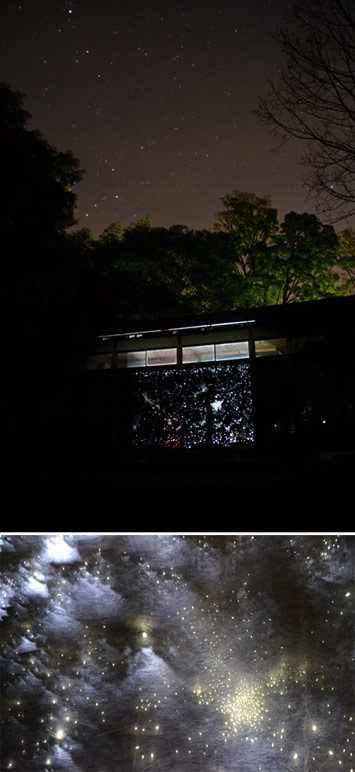
(Stay-Activity-Izu in 2014)
Light and shade undulate to swallow a stream of time
Art involving light is a gift of chance resulting from the passage of time. There was another work that made him feel this same way about the passage of time. In that work, Ando hung a black plastic sheet over windows on the veranda-like porch of a villa located deep in the mountains. He then made small holes with a heated soldering iron one by one in the black plastic sheet from the inner side. This created an arrangement where the incoming light projects the outside scene.
Ando goes on to say: “I imagined the incoming light as gradually spreading the outside scenery throughout the room as the number of holes increased. And the black plastic sheet would ultimately be like a starry sky. Well, most stars we presently see are light reaching the Earth after traveling here for tens of thousands of light years. The original stars creating that light might have already disappeared by the time we see it here on Earth. In the same way, the scenery we see every day includes temporal distances and so we are actually seeing the past. I wanted to express those distances in the scenery we see every day and so decided to give this artistic work a try.”
On the inside of the black plastic sheet with small holes making it resemble a starry sky, Ando hung a thin white curtain and applied an air flow to make it flutter. Each of the holes served as a camera lens to project the countless pieces of inverted outside scenery onto the waving white curtain. Watching the undulating light and shadow that almost seemed to be giving off a sigh proved both fascinating and beautiful. Time seemed to be flowing through this very quiet yet dynamic scene as if just gliding along.
Artists often put a social message into their contemporary art. However, Ando’s art seems to originate from a genuine interest in light. Just hearing the word “photon” seems to make him excited and thrilled. What is the next artistic work of light that Ando plans to create?
Ando also says: “I am now pondering for example what I can do with light technology using equipment that visualizes transient changes in an extremely short time of femtoseconds.*3 At Hamamatsu Photonics I saw an apparatus capable of femtosecond measurements. Since then, how I could use this to create art that expresses both light and time has been constantly at the forefront of my mind.
What will these ideas and concepts from Ando lead us? We can hardly wait to see what surprises wait in store for us.
*1: Photomultiplier tube
Photomultiplier tubes are light sensors with extremely high sensitivity, capable of detecting very-low-level light by converting light energy into electrical energy and then applying electrical current amplification. Photomultiplier tubes also feature high-speed response and are widely used in diverse applications including medical equipment, analytical instruments, and industrial measuring devices.
*2: Feynman
Richard P. Feynman is a physicist born in the United States of America. The “Feynman Lectures on Physics” is a physics textbook based on his university lectures and has been read by a great many people throughout the world.
*3: femtosecond
A femtosecond is one-quadrillionth or 1×10-15 of a second.




